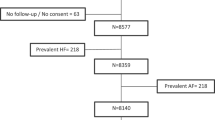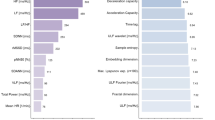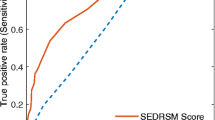Abstract
Introduction
The incidence and significance of impaired heart rate variability (HRV) after acute myocardial infarction (AMI) have not yet been evaluated in cohorts of patients in whom early reperfusion was systematically attempted. Therefore, HRV was evaluated in 412 unselected patients with AMI (311 men, mean age: 60±12 years, anterior AMI in 172 patients) treated with direct coronary angioplasty (PTCA) within 12 hours of symptom onset (mean 3.5±2.0 h). Standard deviation of normal RR intervals (SDNN), square root of the mean of the sum of the squares of differences between adjacent RR intervals (RMSSD) and left ventricular ejection fraction (LVEF, mean: 55±15%) were measured 11±9 days after AMI before discharge. Angiotensin-converting enzyme (ACE) inhibitors and beta-blockers were prescribed at discharge in 81.1% and 70.1% of patients, respectively.
Results
Mean SDNN was 94±30 ms (range 14–155). SDNN was <50 ms in 7% of patients. Mean RMSSD was 34±32 ms (range 2–234). RMSSD was <15 ms in 21% of patients. Low SDNN (<50 ms) was unrelated to gender, age, infarct location or extension of CHD but was related to low LVEF (p<0.001, logistic regression analysis). During mean follow-up of 4.3±3 years, there were 31 deaths; 24 were cardiac. SDNN was higher in long-term survivors (102±39 ms) as compared to nonsurvivors (81±33 ms, p=0.02) but RMSSD was unrelated to the long-term vital status. Four-year survival of patients with a SDNN <50 ms vs >50 ms was 80% vs 92%, respectively (p<0.001, Kaplan Meier analysis). Low SDNN (odds ratio OR=2.0, p<0.05) but not RMSSD was an independent denominator for long-term mortality as were low LVEF (OR=1.0 decrease in LVEF, p<0.01, proportional hazards model) and age (OR=1.1, p<0.001). Only 3/31 fatalities and 1/24 cardiac deaths were predicted by a SDNN <50 ms and only 5/31 fatalities by a RMSSD <15 ms.
Conclusion
The incidence of severely depressed HRV in patients after AMI is low (<10%) in the era of early reperfusion of the infarct vessel using direct PTCA. Mortality in patients with a very low HRV when assessed by SDNN is substantial but the positive predictive value of this parameter is low.
Zusammenfassung
Einleitung
Die Inzidenz und Bedeutung der verminderten Herzfrequenzvariabilität (HRV) nach akutem Myokardinfarkt (AMI) ist bei Patienten, die eine frühe Reperfusion erhielten, bisher nicht systematisch untersucht. Deshalb wurde bei 412 unselektierten Patienten mit AMI eine HRV-Bestimmung (311 Männer, mittleres Alter 60±12 Jahre, Vorderwandinfarkt bei 172 Patienten) durchgeführt. Diese Patienten erhielten eine direkte PTCA innerhalb von 12 Stunden nach Symptombeginn. Die Standardabweichung der RR-Intervalle (SDNN), die Quadratwurzel des Mittelwertes der quadrierten Differenzen der RR-Intervalle (RMSSD) und die linksventrikuläre Ejektionsfraktion (LVEF, im Mittel: 55±15%) wurden 11±9 Tage nach AMI gemessen. ACE-Hemmer und Betablocker wurden in 81.1% bzw. 70.1% der Fälle verordnet.
Ergebnisse
Der mittlere SDNN-Wert betrug 94±30 ms (14–155). Bei 7% der Patienten war die SDNN <50 ms. Die mittlere RMSSD lag bei 34±32 ms (2–234). Bei 21% der Patienten konnte eine RMSSD <15 ms festgestellt werden. Niedrige SDNN (<50 ms) zeigte keinen signifikanten Zusammenhang zu Geschlecht, Alter, Infarktlokalisation oder Ausmaß der koronaren Herzerkrankung. Bei Patienten mit niedriger SDNN und reduzierter LVEF konnte eine hohe Signifikanz (p<0.001) festgestellt werden. Während der Nachbeobachtung von 4.3±3 Jahren gab es 31 Todesfälle: 24 davon kardial. SDNN war höher in Langzeit-Überlebenden (102±39 ms) als im Vergleich zu Nicht-Überlebenden (81±33 ms, p=0.02). RMSSD zeigte keinen signifikanten Zusammenhang mit Langzeit- Parametern. Die 4-Jahre-Überlebensrate betrug bei Patienten mit SDNN <50 ms 80%, im Vergleich zu SDNN >50 ms 92% (p<0.001, Kaplan-Meier-Analyse). Niedrige SDNN (odds ratio OR=2.0, p<0.05), reduzierte LVEF (OR=1.0, p<0.01) und Alter (OR=1.1, p<0.001) waren Prädiktoren der Langzeit-Mortalität, aber nicht RMSSD. Nur 3 von 31 Todesfällen und 1 von 24 kardialen Todesfällen konnten durch eine SDNN <50 ms sowie 5 von 31 Todesfällen durch eine RMSSD <15 ms vorhergesagt warden.
Zusammenfassung
Die Inzidenz der deutlich reduzierten HRV bei Patienten nach AMI in der Ära der frühen Reperfusion des Infarktgefässes durch direkte PTCA ist niedrig (<10%). Die Mortalität bei Patienten mit einer sehr niedrigen HRV, beurteilt durch SDNN, ist beachtlich, aber der positive prädiktive Wert dieses Parameters ist gering.

Similar content being viewed by others
References
Barber MJ, Mueller TM, Davies BG et al (1985) Interruption of sympathetic and vagal-mediated afferent responses by transmural myocardial infarction. Circulation 72:623–631
Bigger JT, Fleiss JL, Steinman RC et al (1992) Correlations among time and frequency domain measures of Heart rate variability two weeks after acute myocardial infarction. Am J Cardiol 69:891–898
Bigger JT, Kleiger RE, Fleiss JL et al (1988) for the Multicenter post-infarction research group. Components of heart rate variability measured during healing of acute myocardial infarction. Am J Cardiol 61:208–215
Bonnemeier H, Hartmann F, Wiegand UK et al (2000) Heart rate variability in patients with acute myocardial infarction undergoing primary coronary angioplasty. Am J Cardiol 85(7):815–820
Casolo GC, Stroder P, Signorini C et al (1992) Heart rate variability during the acute phase of myocardial infarction. Circulation 85:2073–2079
Chakko S, Fernandez A, Sequeira R et al (1996) Heart rate variability during the first 24 hours of successfully reperfused acute myocardial infarction: paradoxic decrease after reperfusion. Am Heart J 132:586–592
Ewing DJ, Neilson JMM, Travis P (1984) New method for assessing parasympathetic activity using 24 hour electrocardiograms. Br Heart J 52:396–402
Kelly PA, Nolan J, Wilson JI et al (1997) Preservation of autonomic function following successful reperfusion with streptokinase within 12 hours after the onset of acute myocardial infarction. Am J Cardiol 79:203–205
Kleiger RE, Miller JP et al (1987) for the Multicenter post-infarction research group. Decreased heart rate variability and its association with increased mortality after acute myocardial infarction. Am J Cardiol 59:256–262
Klingenheben T, Credner S, Grönefeld G et al (1999) Cardiac autonomic tone in risk stratification after myocardial infarct: results of a prospective long-term study of 411 consecutive patients. Z Kardiol 88:400–409
La Rovere MT, Pinna GD, Maestri R et al (2003) Short-term heart rate variability strongly predicts sudden cardiac death in chronic heart failure patients.Circulation 4 107(4):565–570
Lombardi F, Sandrone G, Spinnler MT et al (1996) Heart rate variability in the early phase of an acute myocardial infarction. Am J Cardiol 77:1037–1044
Lotze U, Özbek C, Gerk U et al (1999) Early time course of Heart rate variability after thrombolytic and delayed interventional therapy for acute myocardial infarction. Cardiology 92:256–263
Luria MH, Sapoznikov D, Gilon D et al (1993) Early heart rate variability alterations after acute myocardial infarction. Am Heart J 125:676–681
Malik M, Camm AJ (1990) Heart rate variability. Clin Cardiol 13:570–576
Malik M, Farrell T, Cripps T et al (1989) Heart rate variability in relation to prognosis after myocardial infarction: selection of optimal processing techniques. Eur Heart J 10:1060–1074
Malliani A, Pagani M, Lombardi F et al (1991) Cardiovascular neural regulation explored in the frequency domain. Circulation 84:482–492
Malliani A, Recordati G, Schwartz PJ (1973) Nervous activity of cardiac sympathetic fibers with atrial and ventricular endings. J Physiol (Lond) 229:457–469
Malliani A, Schwartz PJ, Zanchetti A (1969) A sympathetic reflex elicited by experimental coronary artery occlusion. Am J Physiol 217:703–709
Moss AJ, Zareba W, Hall WJ et al (2002) Prophylactic implantation of a defibrillator in patients with myocardial infarction and reduced ejection fraction. N Engl J Med 346: 877–883
Osterhues HH, Kochs M, Hombach V (1998) Time-dependent changes of Heart rate variability after percutaneous transluminal angioplasty. Am Heart J 135:755–761
Pipilis A, Flather M, Ormerod O et al (1991) Heart rate variability in acute myocardial infarction and its association with infarct site and clinical course. Am J Cardiol 67:1137–1139
Rentrop K, Cohen M, Blanke H et al (1985) Changes in collateral filling immediately following controlled coronary occlusion by an angioplasty balloon in man. J Am Coll Cardiol 5:587–592
Rotschild M, Rotschild A, Pfeifer M et al (1988) Temporary decrease in cardiac parasympathetic tone after acute myocardial infarction. Am J Cardiol 62:637–639
Rottman JN, Steinmann RC, Albrecht P et al (1990) Efficient estimation of the heart period power spectrum suitable for physiologic or pharmacologic studies. Am J Cardiol 66:1522–1524
Singh N, Mironov D, Armstrong PW et al (1996) Heart rate variability assessment early after acute myocardial infarction. Circulation 93:1388–1395
Task Force of The European Society of Cardiology, and The North American Society of Pacing, and Electrophysiology (1996) Heart rate variability: standards of measurement, physiological interpretation, and clinical use. Eur Heart J 17:354–381
Thames MD, Klopfenstein HS, Abboud FM et al (1978) Preferential distribution of inhibitory cardiac receptors with vagal afferents to the inferoposterior wall of the left ventricle activated during coronary occlusion in the dog. Circ Res 43:512–519
The Cardiac Insufficiency Bisoprolol Study (CIBIS) (1994) CIBIS Investigators and Committees. A randomized trial of beta-blockade in heart failure. Circulation 90(4):1765–1773
The Thrombolysis in Myocardial Infarction (TIMI) (1985) Study Group. The thrombolysis in myocardial infarction (TIMI) trial. N Engl J Med 312:932–936
Weaver LC, Danos LM, Oehl RS et al (1981) Constrasting reflex influences of cardiac afferent nerves during coronary occlusion. Am J Physiol 240: 620–629
Webb SW, Adgey AAJ, Pantridge JF (1972) Autonomic disturbance at onset of acute myocardial infarction. Br Med J 3:89–92
Wei JY, Markis JE, Malagold M et al (1983) Cardiovascular reflexes stimulated by reperfusion of ischemic myocardium in acute myocardial infarction. Circulation 67:796–801
Zabel M, Klingenheben T, Hohnloser SH (1994) Changes in autonomic tone following thrombolytic therapy for acute myocardial infarction: assessment by analysis of heart rate variability. J Cardiovasc Electrophysiol 5:211–218
Zuanetti G, Neilson JMM, Latini R et al (1996) Prognostic significance of Heart rate variability in post-myocardial infarction patients in the fibrinolytic era. The GISSI-2 results. Circulation 94:432–436
Acknowledgments
We want to thank Konny Speth and Dr. M. Steen-Mueller for excellent technical support.
Conflict of interest
The author declares no conflict of interest
Author information
Authors and Affiliations
Corresponding author
Rights and permissions
About this article
Cite this article
Erdogan, A., Coch, M., Bilgin, M. et al. Prognostic value of heart rate variability after acute myocardial infarction in the era of immediate reperfusion. Herzschr. Elektrophys. 19, 161–168 (2008). https://doi.org/10.1007/s00399-008-0024-3
Received:
Accepted:
Published:
Issue Date:
DOI: https://doi.org/10.1007/s00399-008-0024-3
Keywords
- Heart rate variability (HRV)
- Acute myocardial infarction (AMI)
- Percutaneous transluminal coronary angioplasty (PTCA)




